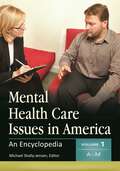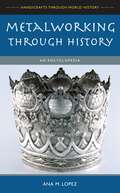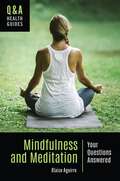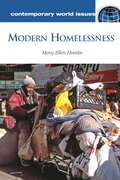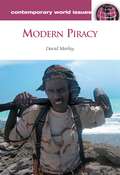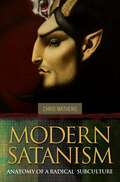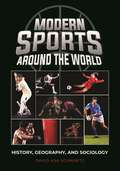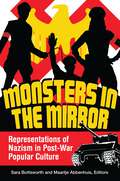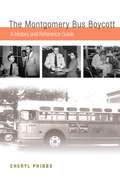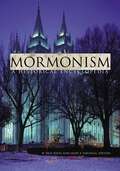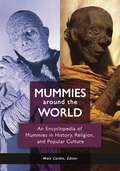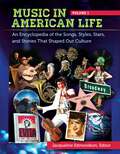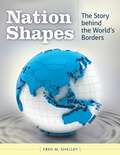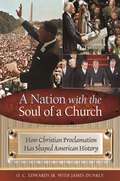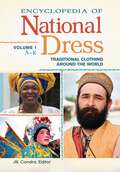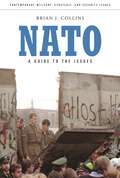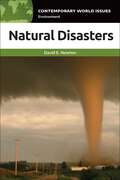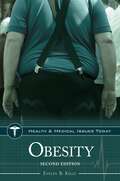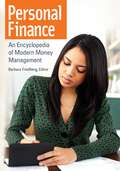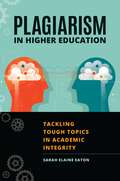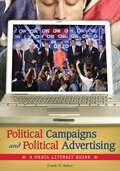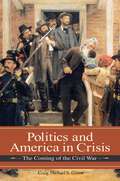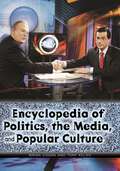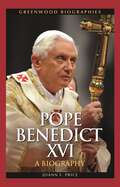- Table View
- List View
Mental Health Care Issues in America [2 volumes]: An Encyclopedia [2 volumes]
by Michael Shally-JensenThis two-volume encyclopedia examines the social, cultural, and political dimensions of mental illness in America.Americans are becoming more cognizant of the importance of mental wellness as incidents of bullying, random shootings, and eating disorders pervade our society. This comprehensive resource provides an expansive overview of mental health and illness in the United States, analyzing the current state of the health care system, and objectively examining the therapies and treatment options traditionally recommended by the medical community.Mental Health Care Issues in America: An Encyclopedia covers major mental disorders, theories, and treatments; delves into major advances and ongoing controversies in the field; and shares the most current research on the subject in varied disciplines, including ethnic studies, criminal justice, education, and social work. Each entry features a clear definition of the issue along with a brief review of its history. Additionally, the author situates the material within the mental health field, as well as within society in general. Organized alphabetically, topics include advocacy, legal issues, media portrayals of psychological disorders, and homelessness and mental illness.
Metalworking through History: An Encyclopedia (Handicrafts through World History)
by Ana M. LopezMetalworking Through History provides a comprehensive, historic overview of the subject of metalworking while exploring it within its cultural context. It is written from the perspective that the crafting of objects in metal is a unique way of understanding a particular time and culture. As a broad encyclopedia of metalworking, it allows the reader to view the different societies and periods that produced work in this medium as part of a global, interrelated practice. Comprised of over sixty entries on relevant time periods, cultures, makers and processes, the book is a much-needed general reference text in the survey of this craft. The subjects span all the major metalworking periods and peoples, from the rituals of African iron smelting to the twentieth century studio movement. Outstanding individual makers are highlighted to give additional insight into the times at which they were active. Furthermore, the materials and techniques used in the act of metalworking are clearly explained in terms that are easily understood by a practitioner with tacit knowledge of the medium. Suggested further readings and cross-references allow for the expansion of research and additional study. It is an excellent first resource for understanding the concepts and terminology of the ancient and pervasive craft of metalworking. Volume includes eight pages of color plates, and black and white photos throughout.Metalworking Through History provides a comprehensive, historic overview of the subject of metalworking while exploring it within its cultural context. It is written from the perspective that the crafting of objects in metal is a unique way of understanding a particular time and culture. As a broad encyclopedia of metalworking, it allows the reader to view the different societies and periods that produced work in this medium as part of a global, interrelated practice. Comprised of over sixty entries on relevant time periods, cultures, makers and processes, the book is a much-needed general reference text in the survey of this craft. The subjects span all the major metalworking periods and peoples, from the rituals of African iron smelting to the twentieth century studio movement. Outstanding individual makers are highlighted to give additional insight into the times at which they were active. Furthermore, the materials and techniques used in the act of metalworking are clearly explained in terms that are easily understood by a practitioner with tacit knowledge of the medium. Suggested further readings and cross-references allow for the expansion of research and additional study. It is an excellent first resource for understanding the concepts and terminology of the ancient and pervasive craft of metalworking. Volume includes eight pages of color plates, and black and white photos throughout.*Art Deco *Marianne Brandt *Chinese *Dark Ages *Enamel *Engraving *Georg Jensen *Judaica *Metals and their Alloys *Native American *Plating and Leaf *Renaissance *June Schwartz *Soldering *South American *Samuel Yellin
Mindfulness and Meditation: Your Questions Answered (Q&A Health Guides)
by Blaise AguirreThis book is an approachable introduction to the topics of mindfulness and meditation as they relate to teens and young adults. The information, guidance, and resources offered make it a valuable tool for anyone curious about this trending topic.Although mindfulness and meditation have been practiced for millennia, modern neurobiologists and psychologists are only just beginning to understand their full potential for improving physical and emotional well-being. Part of Greenwood's Q&A Health Guides series, Mindfulness and Meditation: Your Questions Answered provides clear, concise information for readers interested in the contemporary practice of, and research behind, mindfulness and meditation. It explores definitions of mindfulness and meditation, offers solutions for successfully incorporating them into our often-chaotic lives, and explains their many practical applications and benefits for practitioners. Each book in this series follows a reader-friendly question-and-answer format that anticipates readers' needs and concerns. Prevalent myths and misconceptions are identified and dispelled, and a collection of case studies illustrates key concepts and issues through relatable stories and insightful recommendations. The book also includes a section on health literacy, equipping teens and young adults with practical tools and strategies for finding, evaluating, and using credible sources of health information both on and off the Internet—important skills that contribute to a lifetime of healthy decision-making.
Modern Homelessness: A Reference Handbook (Contemporary World Issues)
by Mary Ellen HombsThis in-depth examination reviews fundamental changes of the past decade that have reduced homelessness in the United States and other Western democracies.Focusing on the last decade, Modern Homelessness: A Reference Handbook examines the issue in the United States and in other nations that have adopted new strategies to address homelessness—and achieved notable results in preventing and ending it. The handbook covers the unprecedented reductions first announced in 2007 and the crucial shifts in strategy and investment, and the results that brought them about. These fundamental changes are analyzed to identify the factors that proved most effective in altering the national and local dialogue and response relative to this daunting issue.In addition to a brief history of homelessness in contemporary times, the handbook examines key developments of the past decade in research, policy, housing models, and service delivery that have been shown to decrease homelessness. These include active partnership among the governments of the United States, Canada, England, Australia, New Zealand, and others that moved the discussion in a new direction. The story is brought up to date with a consideration of the effects of the 2008 economic crisis.
Modern Piracy: A Reference Handbook (Contemporary World Issues)
by David F. MarleyThis reference text explains what modern piracy is, where and why it happens, and what measures are being taken to combat it.While piracy today typically occurs in specific areas—such as Somalia and Southeast Asia—a single pirate attack can involve and affect many different countries. For example, a supertanker traveling in the South China Sea might be owned by a Saudi Arabian oil company, built in South Korea, registered in Liberia, captained by an Italian, and crewed by Filipinos. And, as reports of attacks on commercial vessels and cruise liners become more common, the topic of modern piracy receives ever-increasing international scrutiny.This chapter-based reference handbook examines modern piracy from the mid-1970s to today. The subject is addressed from a global perspective, covering both the causes and consequences of present-day piracy and evaluating its impact on a number of related issues, including international law, commercial shipping, and terrorism.
Modern Satanism: Anatomy of a Radical Subculture
by Chris MathewsIn 1966, Anton LaVey introduced to the world the Church of Satan, an atheistic religion devoted to the philosophy of individualism and pitilessness often associated with Satan. Modern Satanism offers a comprehensive survey and analysis of the church that LaVey built. Satanism has been an open religion for forty years now and operates successfully in its self-created countercultural niche. Given the provocative nature of its name, contemporary Satanism is only superficially understood as an alternative religion/ideology, and all-too-frequently seen as a medieval superstition and associated with rumors of obscure rituals, perverse hedonism, cult-like behavior, and tales of ritual abuse and murder. These may be misconceptions, but the truth behind the unenviable reputation is no less dramatic. Satanism generally eschews supernatural beliefs and embodies a staunchly individualistic, pitiless, anti-egalitarian creed. If there is anything fundamentally diabolical about modern Satanism, it stems more from the echoes of Nazism in its theories than from its horror-comic trappings.Modern Satanism covers the history, ideology, personalities, and practices of the decentralized international movement that contemporary Satanism has become. The work addresses the various beliefs and practices espoused by those who follow it: the ideal of Satan as a rebellious emblem; Satanism's occult, literary, and philosophical influences; the history of the Church of Satan and other Satanic organizations; the ideology of Satanism; Satanism's frequent flirtations and strong parallels with neo-Nazism and other forms of extremism; Satanism in the media and popular culture; and the reasons for Satanism's continuing attractiveness to new converts. Though the tone of the work attempts to remain neutral when discussing historical matters, it is by necessity critical of the subculture's extremist rhetoric and recurring associations with the far right and racialist extremism.
Modern Sports around the World: History, Geography, and Sociology
by David Asa SchwartzModern Sports around the World focuses on the history, geography, sociology, economics, and technological advancements of 50 sports played from India to Ireland.Sports have become an international spectacle that influences nations' foreign policy, world economies, and regional morale. Hundreds of billions of dollars are at stake as governments and multinational corporations rush to make sure they have a place at the table. And yet, sports come from humble beginnings. We are fascinated by who can run the fastest, lift the most weight, jump the highest, swim the farthest, and act with the most precision. The history of sports is the history of the world.Modern Sports around the World examines 50 of the world's most popular sports. Each chapter features one sport and details that sport's origins, global migration, economic forces, media influences, political environment, pop-culture inspirations, scandalous moments, and key individuals. Sports history is a tapestry of sociological variables; Modern Sports around the World weaves them together to create a unique history book that explains not only where humanity has been, but where it might be going.
Monsters in the Mirror: Representations of Nazism in Post-War Popular Culture
by Sara Buttsworth and Maartje Abbenhuis, EditorsThis collection provides readers with a comprehensive overview of postwar representations of Nazism in popular culture, documenting and critiquing their enormous impact and importance.From Charlie Chaplin's The Great Dictator to the depiction of Nazis in the Raiders of the Lost Ark to other various literature, comic books, video games, television programs, and pop music, Nazism has maintained a constant presence in popular culture after World War II. Why are representations of Nazism—which are often used to depict the ultimate expression of human evil—so entrenched in our culture?Each chapter in this book examines this multifaceted topic from different angles, highlighting the different incidences of Nazistic representations in the post-1945 period. The diverse subject matter in this text ranges from analysis of recent allo-historical novels, to the music of the "neo-folk" movement, to fetishes and pornography. Readers will gain insight on how the imagery and symbology of Nazism in popular culture has changed over time and understand how the disconnect between representations of Nazism and the historical record have developed, particularly with regard to the genocide that resulted from Nazi politics.
The Montgomery Bus Boycott: A History and Reference Guide (Non-ser.)
by Cheryl PhibbsA revealing, comprehensive, and detailed account focusing on the people and personalities behind the Montgomery, Alabama, Bus Boycott in 1955–1956, which became the catalyst for a national civil rights movement.The Montgomery Bus Boycott: A History and Reference Guide offers a comprehensive account of a critical turning point in American history. It offers a richly detailed chronological trip through post-World War II Southern society to the early 1960s, then focuses on the day-to-day frustrations, challenges, and victories of the people behind the protest that inspired a nationwide movement.The Montgomery Bus Boycott fills a gap in available resources with its comprehensive portrait of mid-1950s Montgomery—the mainly black, uneducated female protestors, activist Rosa Parks, Dr. King, and the white society desperate to keep intact the only culture they understood. Firsthand news reports, editorials, quotes, eyewitness accounts, and behind-the-scenes stories of political maneuvering help readers experience this dramatic—and still reverberating—victory over oppression.
Mormonism: A Historical Encyclopedia
by W. Paul Reeve and Ardis E. Parshall, EditorsCovering its historic development, important individuals, and central ideas and issues, this encyclopedia offers broad historical coverage of The Church of Jesus Christ of Latter-day Saints.Mormonism: A Historical Encyclopedia helps readers explore a church that has gone from being an object of ridicule and sometimes violent persecution to a worldwide religion, counting prominent businesspeople and political leaders among its members (including former Massachusetts governor and recent presidential candidate Mitt Romney).The encyclopedia begins with an overview of The Church of Jesus Christ of Latter-day Saints—six essays cover the church's history from Joseph Smith's first vision in 1820 to its current global status. This provides a context for subsequent sections of alphabetically organized entries on key events and key figures in Mormon history. A final section looks at important issues such as the church's organization and government, its teachings on family, Mormonism and blacks, Mormonism and women, and Mormonism and Native Americans. Together, these essays and entries, along with revealing primary sources, portray the Mormon experience like no other available reference work.
Mummies around the World: An Encyclopedia of Mummies in History, Religion, and Popular Culture
by Matt CardinPerfect for school and public libraries, this is the only reference book to combine pop culture with science to uncover the mystery behind mummies and the mummification phenomena.Mortality and death have always fascinated humankind. Civilizations from all over the world have practiced mummification as a means of preserving life after death—a ritual which captures the imagination of scientists, artists, and laypeople alike. This comprehensive encyclopedia focuses on all aspects of mummies: their ancient and modern history; their scientific study; their occurrence around the world; the religious and cultural beliefs surrounding them; and their roles in literary and cinematic entertainment.Author and horror guru Matt Cardin brings together 130 original articles written by an international roster of leading scientists and scholars to examine the art, science, and religious rituals of mummification throughout history. Through a combination of factual articles and topical essays, this book reviews cultural beliefs about death; the afterlife; and the interment, entombment, and cremation of human corpses in places like Egypt, Europe, Asia, and Central and South America. Additionally, the book covers the phenomenon of natural mummification where environmental conditions result in the spontaneous preservation of human and animal remains.
Music in American Life [4 volumes]: An Encyclopedia of the Songs, Styles, Stars, and Stories That Shaped Our Culture [4 volumes]
by Jacqueline EdmondsonA fascinating exploration of the relationship between American culture and music as defined by musicians, scholars, and critics from around the world.Music has been the cornerstone of popular culture in the United States since the beginning of our nation's history. From early immigrants sharing the sounds of their native lands to contemporary artists performing benefit concerts for social causes, our country's musical expressions reflect where we, as a people, have been, as well as our hope for the future. This four-volume encyclopedia examines music's influence on contemporary American life, tracing historical connections over time.Music in American Life: An Encyclopedia of the Songs, Styles, Stars, and Stories That Shaped Our Culture demonstrates the symbiotic relationship between this art form and our society. Entries include singers, composers, lyricists, songs, musical genres, places, instruments, technologies, music in films, music in political realms, and music shows on television.
Nation Shapes: The Story behind the World's Borders
by Fred M. ShelleyThis book provides a concise and comprehensive description of all of the borders of every country in the contemporary world, including physical boundaries, their historical evolution, and border-related conflicts with other countries.Nation Shapes: The Story behind the World's Borders examines the importance of country boundaries, the disconnects between these borders, related factors such as cultures, religions, and economies, and how conflicts over boundaries between neighboring countries are articulated. The book is organized geographically and by region of the world: the Americas, Africa, Europe, the Middle East, South and Southeast Asia, East and Southeast Asia, and Australia and Oceania. It provides comprehensive descriptions of the boundaries of each country in the world, the historical evolution of these boundaries, and current and potential future boundary disputes and conflicts. While the work contains an entry for each country, the emphasis is on countries of major importance in the modern global economy.
A Nation with the Soul of a Church: How Christian Proclamation Has Shaped American History
by O. C. Jr. James DunklyFrom the very beginning, religious leaders have influenced the course of American history—sometimes for better, sometimes for worse. This book examines those Christian sermons that set or changed the course of the nation.What did 18th-century preacher Jonathan Edwards really mean to convey with is "Sinners in the Hands of an Angry God" sermon? What Southern minister did most to encourage secession of the Southern states from the Union? And why does Martin Luther King Jr. need to be remembered for more than his "I Have a Dream" speech? This book examines the sermons that have shaped American history from the Massachusetts Bay Colony to the Obama administration. It provides extended biographical treatments of those who preached them, thereby providing readers with the historical context of the sermon, an explanation of what made these orations so effective, and an understanding of the role of religion in American history.Author O.C. Edwards Jr. supplies insightful and interesting coverage of Christian preachers and sermons that will engage anyone interested in America's religious or social history. The book addresses the religious philosophies and speeches of individuals such as William Sloan Coffin Jr., Russell Conwell, Charles Coughlin, Ralph Waldo Emerson, Billy Graham, Anne Hutchinson, Martin Luther King Jr., Patricia Merchant, John Winthrop, and Jeremiah Wright.
Encyclopedia of National Dress [2 volumes]: Traditional Clothing around the World [2 volumes]
by Jill CondraThis two-volume set presents information and images of the varied clothing and textiles of cultures around the world, allowing readers to better appreciate the richness and diversity of human culture and history.The contributors to Encyclopedia of National Dress: Traditional Clothing around the World examine clothing that is symbolic of the people who live in regions all over the world, providing a historical and geographic perspective that illustrates how people dress and explains the reasons behind the material, design, and style. The encyclopedia features a preface and introduction to its contents. Each entry in the encyclopedia includes a short historical and geographical background for the topic before discussing the clothing of people in that country or region of the world. This work will be of great interest to high school students researching fashion, fashion history, or history as well as to undergraduate students and general readers interested in anthropology, textiles, fashion, ethnology, history, or ethnic dress.
NATO: A Guide to the Issues (Contemporary Military, Strategic, and Security Issues)
by Brian J. CollinsThis superb introduction to NATO is written for the national security novice, yet is full of insights for the more seasoned hand interested in how and why NATO reached its current state.In the more than half-century since NATO was founded, there has been endless debate about its purpose, about whether it is meeting that purpose, and about the strategies it employs to that end. Speculation has also been rife about the organization's "imminent demise." Those questions and more are the subject of NATO: A Guide to the Issues.Covering the organization from its founding in 1949 through the present, the guide examines aspects of NATO that have undergone tremendous change over the years, including its purpose, military mission, geographic concept of operations, and membership. At the same time, it explores key aspects of NATO's organization that have remained constant. These include the ability of members to participate in operations as much or as little as they desire, decision-making by consensus, and a general belief that people from different countries working together on a daily basis promotes cooperation, understanding, and friendship.
Natural Disasters: A Reference Handbook (Contemporary World Issues)
by David E. NewtonThis book provides a detailed introduction to natural disasters and the ways in which they have had and continue to have, profound effects on human society.Natural Disasters: A Reference Handbook surveys the impact of these events on human civilization. The opening chapter provides a general history and background of the major types of natural disasters, including earthquakes, volcanic eruptions, severe storms, and forest fires. The information presented in this introduction allows the reader to better understand current issues, problems, and solutions related to natural disasters discussed in subsequent chapters.The book covers the role of natural disasters in human life from earliest recorded history (and, to some extent, even earlier) to the present day. It provides an extensive variety of resources that encourage readers to learn more about the topics discussed. The book is intended for readers in the late middle school to high school age range, as well as adults who may have a special interest in the subject.
Obesity (Health and Medical Issues Today)
by Evelyn B. KellyThis book explores what obesity is, its causes and implications for health, and the many issues and controversies surrounding it, both in the medical community and within society as a whole.Obesity is defined as the state of having a body mass index (BMI) greater than 30. Although it may be easy to identify what obesity is, however, identifying its causes and effects can be more challenging. Genetic, hormonal, environmental, and behavioral factors all play a role in defining our weight, and the consequences of obesity go far beyond medical complications, to include impacts on psychological well-being and social health, and how we think about and address this growing epidemic has become just as controversial as it is important.This second edition of Obesity offers a wealth of new information and features. Coverage of genetic and hormonal causes of obesity has been greatly expanded, as has discussion of medications and surgical techniques to manage obesity. The book reflects our expanded scientific understanding of obesity and delves into medical and societal debates about weight that have emerged in recent years. Also new in this edition is a collection of case studies, each of which helps to make the topics discussed in the book more accessible to readers.
Obesity: Your Questions Answered (Q&A Health Guides)
by Christine L. SelbyThis book serves as an accessible resource for teens who want to learn more about obesity. The information and guidance it offers make it a valuable tool for young adult readers with questions or concerns about their weight.Obesity—represented by a BMI over 30—may be easy to define, but its causes and consequences and how individuals and agencies should address it are not as clear. Is obesity simply the result of eating more calories than one burns, or are other factors involved? Can an individual be obese and healthy? How does obesity affect psychological and social health? Are public health campaigns targeted at reducing obesity helping or hurting? Obesity: Your Questions Answered, a part of Greenwood's Q&A Health Guides series, answers these and other questions related to this high-interest topic. Each book in this series follows a reader-friendly question-and-answer format that anticipates readers' needs and concerns. Prevalent myths and misconceptions are identified and dispelled, and a collection of case studies illustrates key concepts and issues through relatable stories and insightful recommendations. The book also includes a section on health literacy, equipping teens and young adults with practical tools and strategies for finding, evaluating, and using credible sources of health information both on and off the internet—important skills that contribute to a lifetime of healthy decision-making.
Personal Finance: An Encyclopedia of Modern Money Management
by Editor Barbara FriedbergThis jargon-free resource explains the who, what, why, and where of contemporary personal finance in simple, easy-to-grasp language, covering the key people, events, terms, tools, policies, and products that make up modern money management.The ideal roadmap to 21st-century financial literacy, this layman's encyclopedia discusses ideas, concepts, events, and people that inform money management and personal finance. It explains the intricacies of things like investing, saving, debt, credit, and mortgages, and it drills down into complexities like the difference between 401(k) and 403(b) retirement plans. Entries invite the reader to explore common financial topics, such as seeking credit counseling, using credit cards, buying a home, and choosing insurance. Issues such as identity theft, derivatives, and taxes are explored as well.The unique work is topically organized with contributions from both academics and financial professionals. Entries are augmented by entertaining sidebar anecdotes and a glossary, and there is a useful feature that connects readers to online sources, enabling them to keep up with this fast-changing field. A one-stop resource ideal for individuals seeking to understand personal finance, this book will also prove valuable to students taking courses in finance and economics. All readers will come away better equipped to profit from money management and more skilled at making smart financial decisions.
Plagiarism in Higher Education: Tackling Tough Topics in Academic Integrity
by Sarah Elaine EatonWith considerations for students, faculty members, librarians, and researchers, this book will explain and help to mitigate plagiarism in higher education contexts.Plagiarism is a complex issue that affects many stakeholders in higher education, but it isn't always well understood. This text provides an in-depth, evidence-based understanding of plagiarism with the goal of engaging campus communities in informed conversations about proactive approaches to plagiarism.Offering practical suggestions for addressing plagiarism campus-wide, this book tackles such messy topics as self-plagiarism, plagiarism among international students, essay mills, and contract cheating. It also answers such tough questions as:Why do students plagiarize, and why don't faculty always report it?Why are plagiarism cases so hard to manage?What if researchers themselves plagiarize?How can we design better learning assessments to prevent plagiarism?When should we choose human detection versus text-matching software?This nonjudgmental book focuses on academic integrity from a teaching and learning perspective, offering comprehensive insights into various aspects of plagiarism with a particular lens on higher education to benefit the entire campus community.
Political Campaigns and Political Advertising: A Media Literacy Guide
by Frank W. BakerExamining political campaigns and political advertising through the analytical lens of media literacy, this well-illustrated and timely handbook guides readers through the maze of blandishments and spin that is the hallmark of the modern political campaign. It dissects the persuasive strategies embedded in the political messages we encounter every day in the media and demonstrates the importance of critical thinking in evaluating media stories. Key concepts of media literacy are applied to political advertising in traditional media (newspapers, television, radio) and on the Internet, the new frontier of the political advertising wars. Dealing with blogs, social networking, user-generated Web sites, and other electronic formats familiar to young voters, this lively introduction to the new world of political messaging appeals to readers' affinity for visual learning as well as their ability to discern messages in text.Unique in applying media literacy concepts to the political context while directly addressing students and general readers, this book not only explains but graphically demonstrates both established techniques of political framing and the new avenues of persuasion being pioneered in digital media. It will also interest viewers who like their political news in traditional media but unconventional formats.
Politics and America in Crisis: The Coming of the Civil War (Reflections on the Civil War Era)
by Michael GreenThis book unravels the political developments that made the Civil War unavoidable.Politics and America in Crisis: The Coming of the Civil War examines the developments between 1846 and 1861 that pushed the nation to war to see what they reveal about the North, the South, the people leading them, and the issues separating them.As shown here, in the decade and a half before the actual outbreak of the war, the mostly southern Democratic Party's fortunes veered from a presidential election victory in 1852 to the shocking loss of Abraham Lincoln in 1860—an event that marked the coming of age of the young antislavery Republican Party. In examining that sharp reversal, Politics and America in Crisis covers a wide range of key events, including efforts to ban slavery in territories won in the Mexican-American War, the Dred Scott decision, and John Brown's raids.
Encyclopedia of Politics, the Media, and Popular Culture
by Tony Kelso Brian CoganWhether it's television, radio, concerts, live appearances by comedians, Internet websites, or even the political party conventions themselves, the mixing of politics and popular culture is frequently on display. The Encyclopedia of Politics, the Media, and Popular Culture examines the people, major events, media, and controversies in eight thematic chapters and over 150 entries to provide an invaluable resource for any student, scholar, or everyday political junkie needing a comprehensive introduction to the subject.On a typical weeknight in the United States, millions shun the traditional evening network news broadcasts and, instead, later grab their remotes to turn to Comedy Central to catch up on the political happenings of the day, delivered by the comedian Jon Stewart on the faux news program, The Daily Show. Immediately afterwards, they might stay tuned to The Colbert Report for another dosage of hilarious, fake news that, to them, comes across more honestly than the serious version they could watch on CNN. Whether it's television, radio, concerts, live appearances by comedians, Internet websites, or even the political party conventions themselves, the mixing of politics and popular culture is frequently on display. The Encyclopedia of Politics, the Media, and Popular Culture provides in-depth coverage of these fascinating, and often surprising intersections in both historical and contemporary culture.This highly readable and entertaining encyclopedia provides a sweeping survey of the historic and ongoing interplay between politics, the media, and popular culture in eight thought-provoking chapters. The volume is enhanced with the inclusion of over 150 entries to help students and researchers easily locate more in-depth information on topics ranging from political scandals to YouTube.
Pope Benedict XVI: A Biography (Greenwood Biographies)
by Joann F. PriceThis comprehensive biography of Pope Benedict XVI emphasizes his theological positions and contributions as a theologian.Pope Benedict XVI: A Biography is an incisive exploration of the life and career of the current head of the Roman Catholic Church, with an emphasis on his theological positions and contributions as a theologian. Written by a Catholic priest who is an expert on Bavarian theology, the book looks at Benedict's family life, his teen years in Nazi Germany, his rise in the Church, and the beliefs that shape his Papacy.Readers of this biography will learn that, in addition to his native German, Benedict XVI speaks Italian, French, English, Spanish, and Latin fluently, has a knowledge of Portuguese, and can read ancient Greek and biblical Hebrew. They will discover that he plays the piano and is very fond of cats. Perhaps surprisingly, they will find that during the time of the Second Vatican Council, the Pope was viewed as a reformer, and that he continues to regard himself as a supporter of the Council's teaching, holding, however, that those teachings have been widely misinterpreted. All this and more make for a fascinating—and instructive—reading experience.
